
Cotahuasi Canyon, located about 200 kilometers (124 miles) from Arequipa in the heart of the Southern Andes, is one of the deepest canyons in the world. It is formed by the flow of the Cotahuasi River as it carves its way between two peaks, Coropuna and Sulimana, each of which towers over the ravine at more than 20,000 feet above sea level. At its deepest point, the canyon cuts roughly 3,534 meters (11,595 feet) into the earth – only slightly shallower than its famous neighbor, Colca Canyon.
While Colca Canyon is a more popular attraction due to its greater accessibility, Cotahuasi Canyon is the preferred destination of off-the-beaten path thrill-seekers and extreme outdoor recreation enthusiasts. To get the full experience of this natural wonder, you need to set aside about a week.
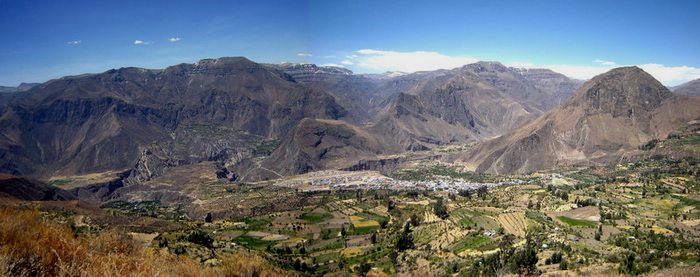 A Cotahuasi-style panorama Photo by By Manouel/Wikimedia Commons
A Cotahuasi-style panorama Photo by By Manouel/Wikimedia Commons
A remote location makes the journey to Cotahuasi Canyon a bit of a challenge. The roads are bumpy and windy, but they also to offer scenic views of Inca and Wari ruins nestled between enormous peaks. Much of the canyon has been designated as part of the Cotahuasi Sub-basin Landscapes Reserve which aims to preserve the natural environment for the plants and animals that populate this unique geographical landscape.
Popular recreation activities include hiking (lots of it), Class V whitewater rapids for extreme rafting and kayaking, mountain climbing, biking, birdwatching (most notably the Andean Condor ), and exploring archeological wonders. The best time to trek the canyon is from April to November when the region is not experiencing heavy rainfall. Make sure to thoroughly research the best time to visit Peru if you plan to visit other destinations.
What to wear: Essential wardrobe elements include loose clothing, comfortable shoes, and a hat to protect eyes and skin from the intense Andean sun. It is also a good idea to bring sunscreen (SPF 30 and higher) and copious amounts of bug spray to repel mosquitos.
Arequipa Tours:
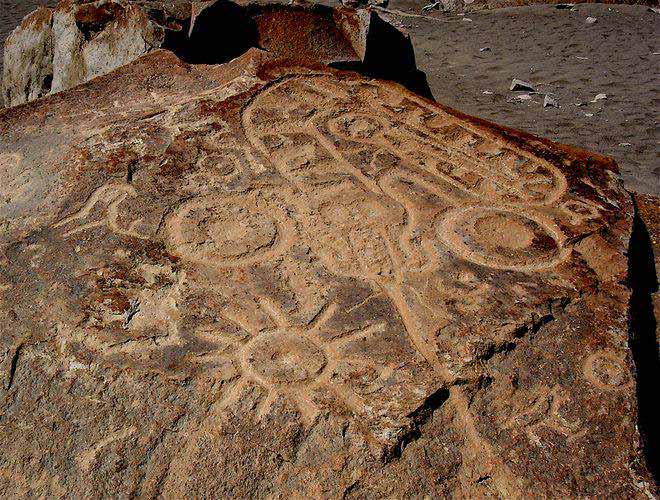 Explore remains of a civilization from over 1,000 years ago! Photo by
Derek Preston/Flickr
Explore remains of a civilization from over 1,000 years ago! Photo by
Derek Preston/Flickr
Located near the small town of Corire en route to Cotahuasi, these ancient cave paintings are estimated to be more than 1,000 years old, pre-dating the rise of the Inca Empire by almost 500 years. Archeologists have catalogued nearly 5,000 depictions of birds, animals and humans etched into the white volcanic rock that protrude from the mountain sides. Toro Muerto means “Dead Bull” in Spanish, in reference to the herds of cattle that often died from dehydration on the overland journey from the mountains to the coast in colonial times.
To visit the petroglyphs, any of the three bus companies will make a stop in Corire, which is about 3 hours from Arequipa. From Corire, a 2-kilometer (1.2-mile) trail leads to a checkpoint where visitors must sign in and pay a small fee. Another option is to take a full-day, 4-wheel-drive tour from Arequipa. This option is more convenient, albeit more expensive.
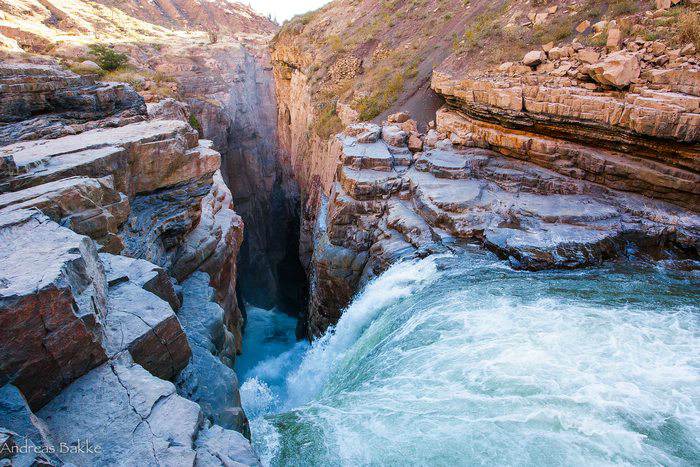 Meet Sipia Waterfall, Cotahuasi’s most photogenic attraction. Photo by
Andreas Bakke/Photoblog from South America
Meet Sipia Waterfall, Cotahuasi’s most photogenic attraction. Photo by
Andreas Bakke/Photoblog from South America
This magnificent waterfall pours off the edge of a cliff, crashing impressively 150 meters (492 feet) below. It is one of Cotahuasi Canyon’s most scenic attractions. The waterfall is accessible either by foot or by van and is located about 10 kilometers (a bit more than 6 miles) from the town of Cotahuasi.
Known for the therapeutic and healing qualities of its sulfuric waters, the Luicho Thermal Baths are the product of geothermal activity that boils beneath the earth’s surface. The volcanoes in the vicinity of Cotahuasi Canyon are inactive, but their thermal activity heats the baths’ waters to temperatures of between 33°C and 38°C (90°F to 100°F). Located about 17 kilometers (about 10.5 miles) from the town of Cotahuasi in the small village of Alca, the Luicho Thermal Baths are recommended for people suffering from ailments such as arthritis, muscular atrophy, rheumatism, and stress. A small fee of S/.5 ($2 US) is collected upon entry.
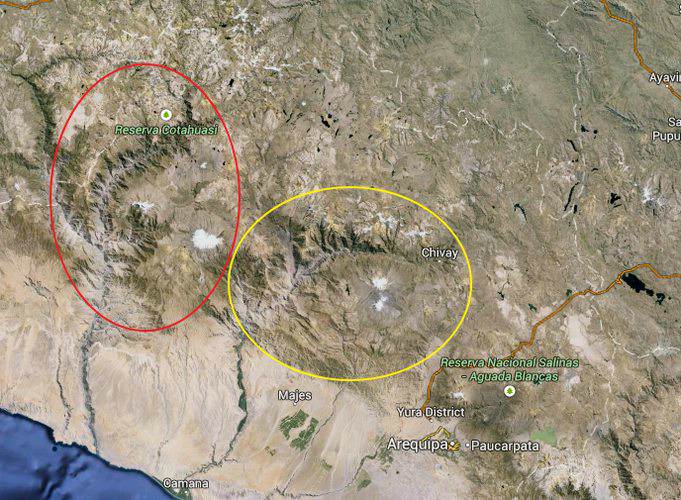 Cotahuasi Canyon (red circle) is neighbors with Colca Cayon (yellow circle).
Photo from Google Earth
Cotahuasi Canyon (red circle) is neighbors with Colca Cayon (yellow circle).
Photo from Google Earth
From Arequipa, there is just one road to the canyon, and it is accessible by bus or combi (public transportation vans that seat 9 to 12 people). It’s a 10-12 hour trip from Arequipa to the small town of Cotahuasi. Three bus companies service the area: Reyna, Alex, and Inmaculada Concepción. All of them typically depart from Arequipa around 5pm to arrive in Cotahuasi around 5am the following day. As an alternative to bus travel, 4×4 vehicles are available for rent in Arequipa, though you will want to make sure to be fully insured. To get to some of the attractions in the vicinity, a local combi is your best bet. Costs range between S/.10 to S/.30 depending on how far you are going.
Cotahuasi Canyon is very remote and does not receive a lot of tourists. Roads are narrow and undeveloped, so the fourteen-hour bus ride from Arequipa to the town of Cotahuasi can feel like an epic journey into the wilderness. But this is all part of the appeal, “to visit a natural wonder that is not so commercialized, like Colca Canyon,” according to Kendra, one of our travel advisors who recently had the opportunity to trek to the secluded canyon.
Many people choose to camp when traveling to and around Cotahuasi Canyon, and there is ample space to do so. It is common to camp in public places, fields, and even on someone’s private property – with prior consent from the property owner and negotiation of a fee. A few hostels in the villages also welcome tourists with open arms. Most include a continental breakfast and hot water, which are often considered luxuries even to the local people. You will be able to check-in to a room (more than likely shared) for about S/30. Make sure to keep an eye on your personal belongings while in the towns and villages. The hiking paths are typically deserted.
The Peru For Less team can help you plan your dream trip to this amazing country. Contact us to start planning your trip today!
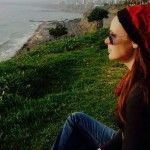
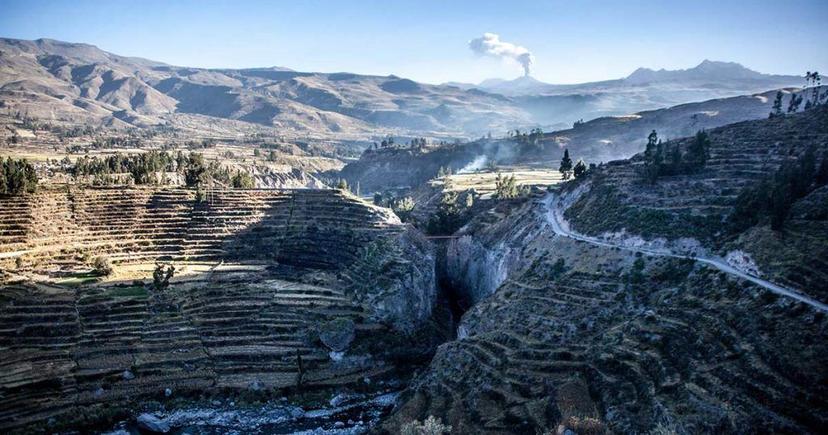

Email: [email protected]
Sign up to receive our newsletter for great articles, stunning photos, and special deals.